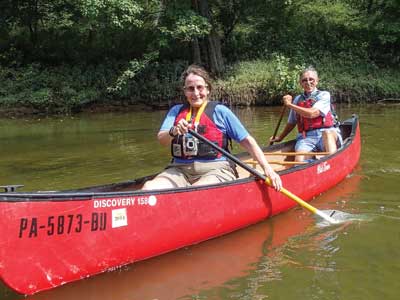When outdoor enthusiasts Roy Weil and Mary Shaw established the Canoe Access Development Fund through the Western Pennsylvania Conservancy in 2008, they assumed canoeists and kayakers would be the main beneficiaries of improved access sites on local waterways.
More than 10 years and 67 access sites later, they’ve seen an unanticipated and even more positive outcome.
“The affected audience for the sites is not just canoeists and fishermen,” Mary said. “It’s the communities.”
 Roy and Mary approached the Conservancy in hopes that WPC would be willing to provide better access to the region's navigable waterways for canoeists and kayakers. Nick Pinizzotto, former WPC associate vice president of watershed conservation, conceived the idea of working with watershed associations and other community organizations. Eli Long, WPC watershed manager, West Branch Susquehanna Region, implemented the program, working with communities to provide better access to the region's waterways. These accesses made streams accessible to people who otherwise might never have dipped their toes into a riffle or drifted down a lazy river.
Roy and Mary approached the Conservancy in hopes that WPC would be willing to provide better access to the region's navigable waterways for canoeists and kayakers. Nick Pinizzotto, former WPC associate vice president of watershed conservation, conceived the idea of working with watershed associations and other community organizations. Eli Long, WPC watershed manager, West Branch Susquehanna Region, implemented the program, working with communities to provide better access to the region's waterways. These accesses made streams accessible to people who otherwise might never have dipped their toes into a riffle or drifted down a lazy river.
Jacobs Creek Watershed Association has built three canoe access sites with WPC funding. Annie Quinn, the watershed’s executive director, said when she started in 2015 she knew she had to make people care whether the water was healthy and clean. “I realized there was no access … no way a human being could walk down and touch the creek,” so she applied for canoe access funding. After she spent years educating the public about the health of the stream and inspiring the community to get involved, “A lot of people are using the three sites,” Annie says. “A birder has been using one site because it’s the quietest place to hear bird calls.”
Susan Ansell, a grandmother and former teacher from Scottdale, paddled Jacobs Creek during a sojourn, blissfully floating downstream and enjoying the ducks and flowers. “The idea that anyone could ever step into Jacobs Creek is amazing to people my age,” Susan says, noting that her three grown children and six grandchildren anticipate being on the water frequently. “This is great for the next generation.”
Roy and Mary note that communities are also seeing business opportunities associated with access sites. Watersheds like Jacobs Creek and Stony Creek, which have systematic water trails created by stringing together several water access sites, are seeing not only more people accessing the river but more businesses springing up in the community. “It brings people in, and creates an opportunity for local commercial operations to provide canoes and shuttles,” Mary says.
When people visit communities to recreate on the water or trails, other businesses such as hotels and restaurants can benefit as well. Susan’s oldest daughter owns Maple Bottom Farm near Scottdale, and she and Susan are opening a bed and breakfast on the property. “We’d like to see agritourism businesses like ours grow in conjunction with rails to trails and water recreation,” she says. “Water quality builds community and business.”
Susan Huba, executive director of the Loyalhanna Watershed Association, says her organization has received funding for several launch sites. The organization’s Loyalhanna Sojourn, a one-day paddle of the Loyalhanna Creek from Latrobe to New Alexandria, has seen attendance increase to 232 participants over six years.
“A new outfitter, Two Dam Kayak Rentals, has taken up residence in New Alexandria and offers kayak rentals and shuttles to routes along the Loyalhanna Creek and neighboring rivers,” Susan continues. “Bringing visibility to our area waterways is beneficial to the communities, businesses and organizations that surround them and work to protect and restore their water resources.”
Canoe access sites need to be designed and owned locally, Mary agrees, so the community takes pride and ownership and the sites are used and maintained. “When the Conservancy helps communities do that, it helps all of us.”
Roy and Mary have created or edited guidebooks about canoeing, bicycling and other outdoor adventures to help people understand and enjoy the region’s natural features. You can view Canoeing Guide to Western Pennsylvania and Northern West Virginia and purchase Freewheeling Easy in Western Pennsylvania.
